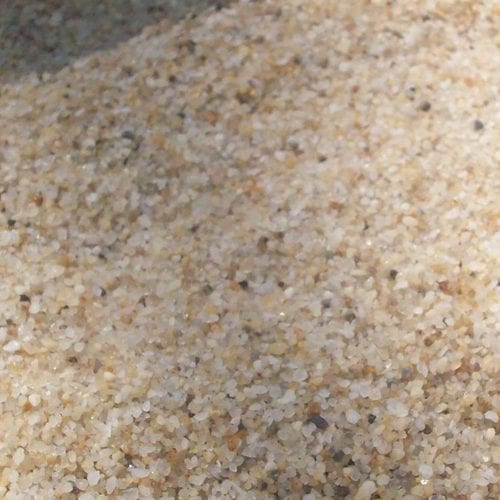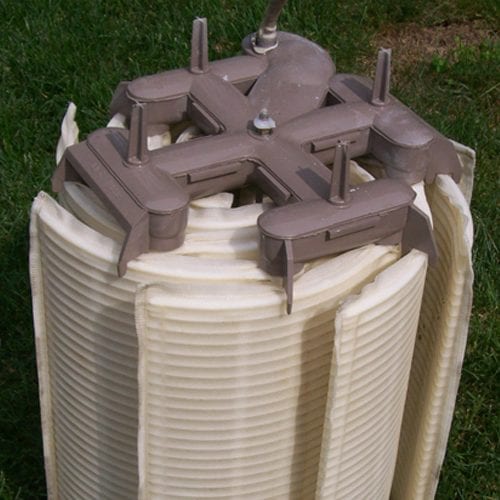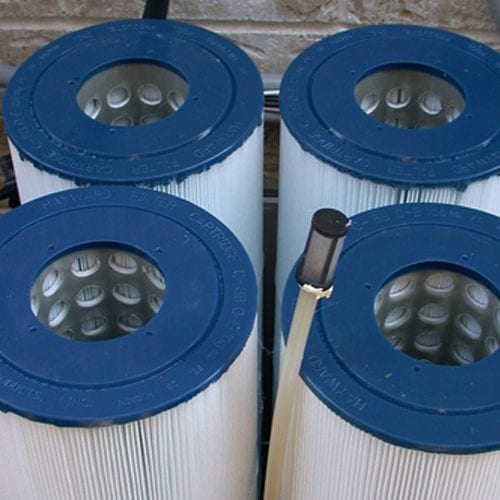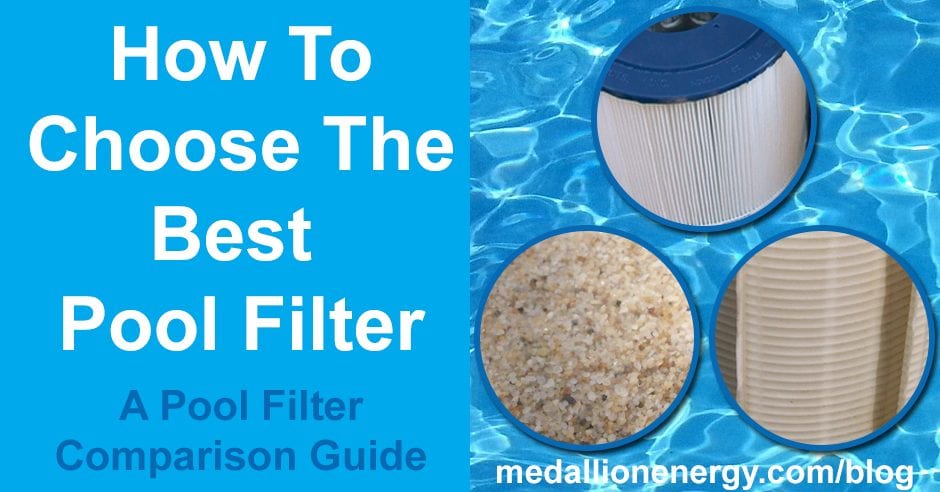“What’s the best pool filter for me?”
Now there’s a question every pool owner has asked at least once.
And it’s actually one of the most important questions you can ask as a pool owner.
Why?
Because it’s your filter system that’s responsible for maintaining good circulation/water flow. It keeps your pool free of contaminants and debris.
In other words, your filter is the key to a clean and healthy swimming pool. So choosing the right one is crucial.
But thankfully, no matter which filter you choose, you can’t go wrong. Each pool filter comes with its own advantages, but all three do an excellent job of keeping your water clean.
Although you might be wondering: What are the different types of pool filters? And how do I choose the “best” one?
If so, keep reading, because that’s what this post is all about. In this pool filter comparison guide, we outline the features and benefits of each type to help you decide which pool filter is best for you — from lifespan to replacement cost and everything in between. After reading this guide, you’ll have all the knowledge you need to make a decision.
So let’s get right into it.
How To Choose The Best Pool Filter
A Pool Heater Comparison Guide
Sand



Overview: Sand Pool Filters
If you’re wondering whether or not a sand filter is actually made up of sand, the answer is yes. In fact, there’s not much else in a sand filter aside from the main pipe going down the middle, and plastic laterals that sit at the bottom.
Of the three types of pool filters we’re discussing today, Sand filters feature the simplest design. They’re also one of the more common choices next to cartridge filters.
How it works:
As water enters the filters, it’s pulled downward and strained through a mass of sand. The sand acts as the filter media, filtering out contaminants and keeping them contained. As contaminants accumulate, water moves slower and slower through the unit. Hence why each sand filter comes equipped with a backwash valve, used to push out old sand and contaminants.
Sand Pool Filter Cost
Sand filters are usually the cheapest option, with an average cost of around $250
Filter Media: Pool Sand
Sand pool filters use sand or sand-based mixtures as their filter media. The sand forms a “bed” that traps contaminants and filters out impurities. It can be cleaned out and “reset” with a backwash.
Filtering Capability/Sensitivity: 20-40 microns
Sand filters can filter contaminants down to 20-40 microns. In case you’re wondering, that’s much smaller than a strand of human hair.
Lifespan: 5-7 years
The sand filter itself will last anywhere from 5-7 years of normal use. But sand needs replacement every few months.
Filter Media Cost: $8 per 50-pound bag of sand
You can purchase pool filter sand for as little as $8 per 50-pound bag. How much sand you’ll need is entirely dependent on the size of your pool filter. Regardless, sand filters offer the lowest filter media cost of the three pool filter options.
Water Usage: High (300-500 gallons)
Every pool filter will process the same amount of water. But by water usage, we’re referring to how much water is used during the cleaning process. For sand filters, cleaning involves a thorough backwashing. Which typically means flushing out a significant amount of water.
For most sand filters, the backwashing process involves anywhere from 300 to 500 gallons of water.
Maintenance: Low
This is where sand pool filters shine. Due to their simple design, maintenance isn’t really a big deal. Aside from replacing your sand, and the occasional backwash, maintaining a sand pool filter is pretty easy. And even when you do have to replace your sand, you’ll find that it’s a relatively straightforward process with the right approach.
Bottom Line: If low maintenance is your top priority, then a sand filter may be the best pool filter for you.
Sand Pool Filter PROS and CONS
PROS
- Low maintenance
- Low-cost filter media
- Long lasting filter media
CONS
- Uses a lot of water (backwashing)
- Least sensitive filter media
- Replacing filter sand can be difficult
Related: How To Change Pool Filter Sand
DE Filters (Diatomaceous Earth)



Overview: DE Filters
First things first: What is Diatomaceous Earth?
To be specific, it’s a powder derived from fossilized diatoms, which represent a major algae group. But don’t worry, they won’t turn your pool green. Just think “fossil powder”.
Now that you know what “D.E” stands for, let’s move on.
How it works:
DE Filters are comprised of a tank containing 8 fabric grids coated in DE powder. As water flows through the filter, contaminants are contained within the grids. The grids catch a wide range of impurities that pass through the unit, but it’s the powder that adds an extra level of security.
Working similar to sand, the DE powder coating allows the filter to trap contaminants as small as 3 microns. Which is insanely small. Hence why these filters have a reputation for producing the cleanest water.
DE Pool Filter Cost: High ($200-$600)
You get what you pay for with DE Filters. Among the three types of pool filters, DE filters are the most expensive. Ranging anywhere from $200 – $600. But that’s just what you have to expect when you want the best filtering capability.
Filter Media: DE Grid & Powder
DE Filters feature a series of powder coated, fabric grids.
Filtering Capability/Sensitivity: 3-5 microns
DE Filters are known for their sensitivity. Out of the three pool filter types, DE Filters can filter the smallest contaminants down to 3 microns. This means that they feature the best pool filter media of the three filter types.
Key Point: If you’re looking for the highest filtering capability/performance, then a DE Filter may be the best pool filter for you
LifeSpan: 7 – 10 years
DE Filters also provide the longest lasting filter media, with most grid sets lasting anywhere from 7 – 10 years (with good maintenance).
Filter Media Cost: Medium
Full sets of filter grids can be purchased for as little as $100.
Individual filter grids can usually be purchased at around $20 each.
Water Usage: High
Like sand filters, DE Filters use backwashing to keep their filter media clean. So while you get some of the finest filtering available, you’ll also be using up a plenty of water every time you clean/backwash.
But due to the unique design of DE Filter, pool owners can also take advantage of “bumping”. Bumping is a shorter version (15-30 seconds) of backwashing that loosens up the powder and dirt that accumulates in the filter. This prevents contaminants from clumping up on the fabric and reduces the amount of backwashing needed throughout the lifespan of the filter media.
Maintenance: High
The best filtering capability doesn’t come without a cost. DE Filters typically involve the most maintenance of the three. Requiring a recharge of DE Powder after every backwash, as well as an inspection of the filter media.
Since DE Filters feature the most complex design, they’re a bit more prone to wear and tear. So you’ll want to keep a lookout for any rips in the fabric and replace worn out grids as needed.
DE Pool Filter PROS and Cons
PROS
- Highest filtering capability
- Long lifespan
- Easy to replace filter media
CONS
- Expensive unit price
- High maintenance
- Heavy water use (backwashing)
Related: How To Clean a DE Filter
Cartridge Pool Filters



Overview: Cartridge Pool Filter
Cartridge filters are the happy medium between sand filters and DE Filters. They offer great filtering sensitivity and conservative water usage. Their design is simple, consisting of a set of four filter cartridges.
Each cartridge provides a channel for contaminants to be trapped and filtered out through.
Cartridge Pool Filter Cost: High ($200-$600)
Most cartridge pool filters are cheaper than DE Filters but more expensive than most Sand Filters. With prices ranging from $200 to $600.
Filter Media: Cartridges
Cartridge pool filters use 4 cylindrical fiber cartridges to trap contaminants. The fibers have a paper-like feel and offer filtering capabilities that nearly rival DE filters, reaching all the way down to 10 microns.
Filtering Capability/Sensitivity: 10 -15 microns
Although not as much as DE Filters, Cartridge filters are still very sensitive — catching contaminants as small as 10 microns.
In addition, because of their design, cartridge filters provide the most surface area. This makes them especially ideal for pumps running at low speeds.
LifeSpan: 3 – 5 years
Filter cartridges won’t last as long as sand or DE grids, but they’re fairly easy to replace. And if you clean them well enough, they can last as long as 5 years before needing replacement.
In theory, you can likely keep cleaning the cartridges and reusing them past the 5-year mark. But you’ll notice some significant drops in filtering performance, which is why it’s so important to know when to replace your pool filter cartridges.
Filter Media Cost: Medium
You can purchase a set of four cartridges for around $150-$200
A single cartridge costs around $60.
But in most cases, when the time comes, it’s best to replace the full set.
Water Usage: Low (100 gallons)
This is where cartridge filters are king. They don’t include a backwash valve, so naturally, they use the least water.
Especially since cleaning really only involves removing the cartridges and rinsing them down. Hence why cartridge filters are a great option for people who live in areas affected by droughts, or strict city codes for water usage.
Key Point: If you’re looking for the most economical option that offers solid performance, a cartridge filter may be the best pool filter for you
Maintenance: Medium
Aside from the occasional cleaning and cartridge replacement, there’s not a lot to worry about. Granted, you’ll have to hose down each individual cartridge when cleaning, which can make the process time-consuming. But not nearly as intensive as maintaining DE Filters.
Bottom line: You’ll have to maintain them more often than sand filters, but the process is fairly simple compared to DE Filters.
PROS and CONS
Pros
- Economical (low water use)
- Good filtering capability
- Easy to clean
Cons
- Requires more frequent cleaning
- Shorter filter media lifespan
- Expensive filter media
Pool Filter Comparison Chart
| FILTER TYPE | Sand | DE (Diatomaceous Earth) | Cartridge |
| FILTERING SENSITIVITY | 20-40 microns | 3-5 microns | 10-15 microns |
| FILTER MEDIA LIFESPAN | 5-7 years | 7-10 years | 3-5 years |
| COST | $10 per bag | $100 per filter grid set (8) | $150 per cartridge set (4) |
| WATER USAGE | High | High | Low |
| MAINTENANCE | Low | High | Medium |
Closing thoughts on the different types of pool filters
As you’ve learned from reading this guide, deciding which filter is best for you is highly dependent on your preferences and situation.
While sand filters offer low maintenance and long lasting filter media, DE Filters boast the most exceptional filtering sensitivity. And cartridge filters offer economical performance and a moderate level of maintenance. So if we had to make quick suggestions for each, here’s what they are:
If you want a pool filter that requires the least maintenance, choose a Sand Filter
If you want the best cost (time and money) to performance ratio, choose a Cartridge Filter
If you want the best filtering sensitivity money can buy, go with a Diatomaceous Earth Filter (DE Filter)
If you liked this post, you might also like:


